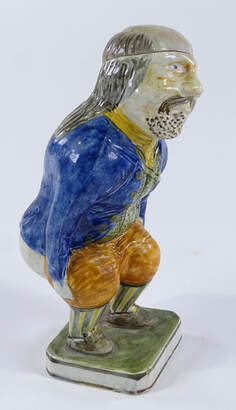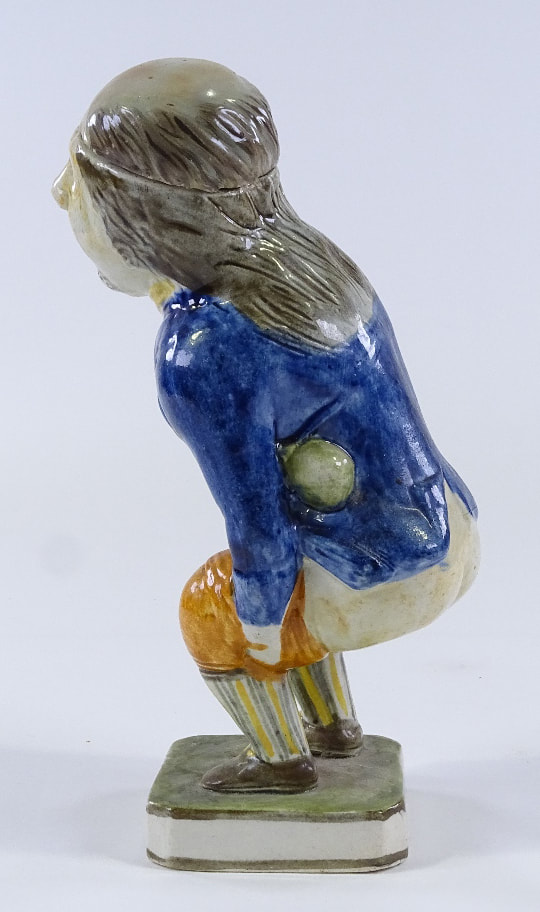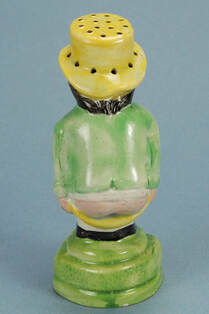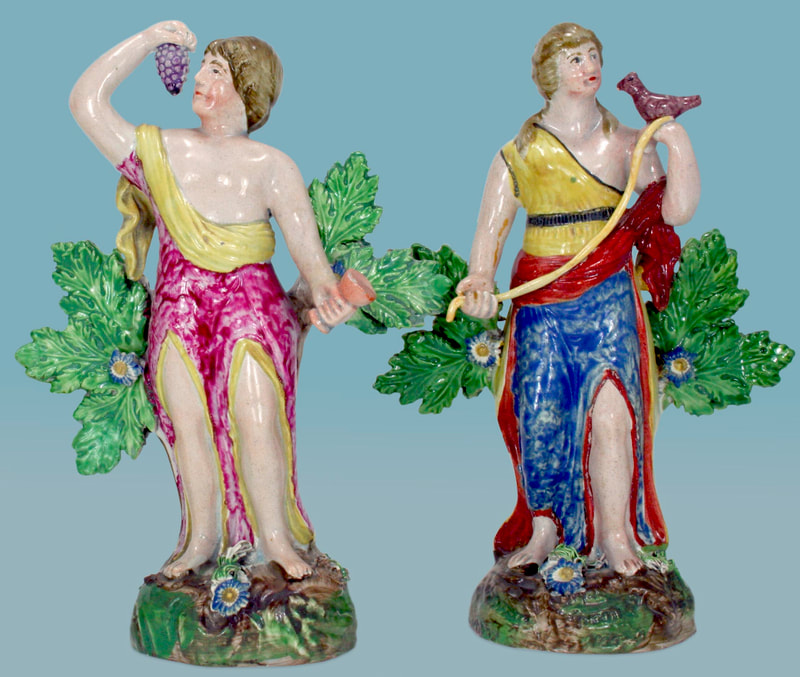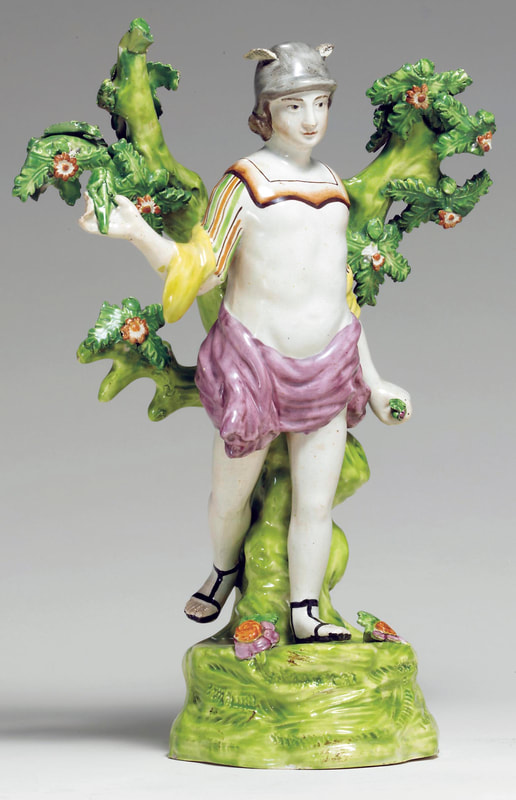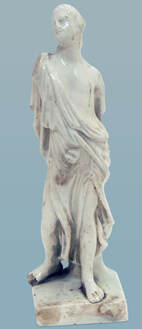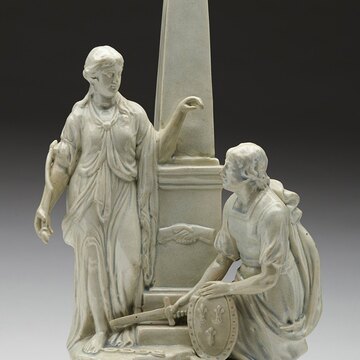|
I have updated my three volumes of my eBook, Obsession, to reflect changes in our collection and advances in my knowledge. The book is available for free download on my Books menu on this site.
0 Comments
As 2021 fades with a whimper, I look back on the extraordinary figures that have crossed my path. The variety that emanated from Staffordshire kilns is seemingly endless. I confine my collection to enamel-painted figures. If not, I would have had to bid on this remarkable underglaze-decorated figure of Roger Giles. Roger Giles was a Devonshire schoolteacher and jack-of-all-trades. His claim to fame rests is that he advertised for sale fresh eggs “new laid by him every day”. Staffordshire figure potters fashioned crudely comical figures of a squatting gentleman that are said to represent Giles laying those eggs. They were made well into the Victorian era, and nasty fake-similes persist today, but a pre-1840 Roger Giles can prove elusive. Add to that, some can be a tad too vulgar for my taste. Below is my Roger Giles, made by the "Sherratt" pot bank. Like others of his ilk, he has holes in his hat, so perhaps he was intended as a pepper pot or hat pin holder. Like most, he is about 4.5 inches tall--significantly smaller than the gentleman at the top of this post. At a good 8 inches, that Roger Giles is by far the biggest I have seen, and the top of his head is removable (is he a jar?). He oozes personality, and I am pleased he has found a home in a remarkably interesting and fine collection. Another unrecorded figure that quietly changed hands recently was this gem that went through auction in a lot with another. Described as a "figure playing a lyre," he is Apollo, but given the girly hairstyle (not to mention our "Woke" world), the description was probably intentionally gender-neutral. What is interesting about Apollo is that he can be attributed to John Dale. The distinctive bocage flowers nail the attribution, and the decoration of the base is rather like that on other Dale figures. These same Dale features (and others) are apparent on the spill vase below. (See Staffordshire Figures 1780-1840, vol.1 for Dale attributes.) John Dale was active as a potter from 1818, and Apollo looks like a circa 1820s figure. Dale made other classical figures in the same style (with various but typical Dale bocages and bases), as recorded in Staffordshire Figures 1780-1840, vol.4. From top left they Aesculapius, Bacchus, Venus, Juno, and Mercury. Today, all are particularly rare and are known from one or two examples at most. Click each image to enlarge. Clearly there was a significant market for classical figures in the 1820s, yet collectors tend to relegate those figures to earlier decades. How wrong that would be, and a message from the grave hammers home that lesson. Let me explain. The enamels on this figure group of Peace below suggest it was made in the 1790s. On the base are a helmet and other implements of war as well as a broken chain, all of which symbolize the fight for freedom. The male figure holds a shield decorated with the fleur-de-lys of the French monarchy, and he is laying down his arms at the feet of the the female, who is Peace. She is offering him a Liberty bonnet. Clasped hands of fraternity are on the obelisk, so the group has been interpreted as suggesting or commemorating a peaceful resolution of the French Revolution. Given that, a date in the 1790s seems appropriate for this group. As the French revolution was finite, one would have expected this model to have outlived its usefulness by 1800. Would you even consider dating an example to the 1820s? No? Think again! Fast forward to 1974, and this unpainted group, from the same molds, was unearthed in Staffordshire. (The helmet probably went the way of the lady's arm!) The potter Enoch Wood was a great recorder of the events of his day. For that purpose, he buried caches of his pottery for future historians to find. When the foundation of St. Paul's Church, Burslem, was laid in 1828, Wood left a cache beneath it. Included was this group of Peace. A demolition contractor unearthed it in 1974, and it came to auction last year. No saying for certain when it was made, but I strongly suspect it was made in the 1820s rather than the 1790s. Also in the cache was a shard corresponding to a figure of Medea, as seen below. Again, it seems reasonable to conclude that as the shard was made in the 1820s, the figure may have been made then too. While there is no hard line in the sand, classical figures on square bases with a line are assumed to predate 1815. Enoch Wood's legacy does not end there. In 1938, a cache of his wares was unearthed beneath the Burslem Old Town Hall. From their subject matter, they date to the 1820s. Among them were shards of classical figures of Bacchus and Ariadne that, like Medea, we might have relegated to an earlier period based on their bases, their designs, and their subject matter. The shards are below. Alongside the shard of Ariadne is a figure corresponding to it. Does that mean that all examples of Bacchus and Ariadne from these molds date to the 1820s? Not at all. Rather, it means that we have to broaden our time horizon. We must look beyond square bases to determine a date. The mode of decoration and the colors of the enamels can be very helpful. The soft turquoise enamel on Ariadne was in great favor in the 1790s, but that is not enough to assign a date with confidence. Turquoise had no sell-by date, and it certainly may have been used for a lot longer. I only know of three examples of the large group of Peace: the two shown above, and the one below. I apologize for the partial photo, but the full image is lost somewhere in my archive. Because it is uncolored, the details of the modeling are particularly crisp. But, as there are no enamels to guide dating (however unreliable or reliable that might be) we are up the creek without a paddle. This group could have been made at any time from the 1790s into the late 1820s.
We rely on multiple features to support an attribution, but we tend to be rather gung-ho about dating. I intend being very much more circumspect henceforth. It bothers me that collectors and dealers alike consistently pull the dates of their pieces forward in the belief that an earlier dates equates with greater worth. That is simply ridiculous. Let us all practice greater caution in the new year. PS. Andrew Dando has a lovely little "Sherratt" Roger Giles in stock currently. Like mine, shown above but in a red coat. |
Archives
February 2024
All material on this website is protected by copyright law. You may link to this site from your site, but please contact Myrna if you wish to reproduce any of this material elsewhere. |



